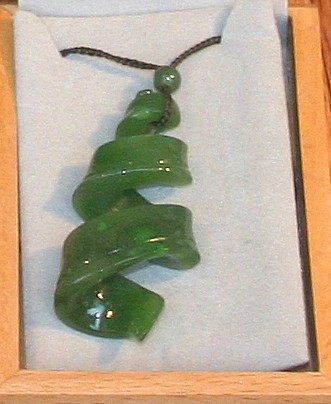|
.
Nephrite Mineral Facts:
Chemical Formula: Ca2(Mg,Fe)5Si8O22(OH)2
A compact form of actinolite,
tremolite and small amounts of other minerals. It is technically a rock
rather than a mineral.
Colors:
Light to very dark green, yellow to
brown, white, gray or black.
White in color when free from iron
and other impurities. In the green varieties a little iron replaces some
magnesium.
Hardness:
6 to 6.5
Density: 2.9
to 3.1
Cleavage:
Massive form, no
cleavage observable.
Crystallography: Monoclinic
Massive and compact,
finely
fibrous.
Fractures are splintery.
Luster:.
Vitreous
luster. Normally translucent to opaque.
Optics:
(Refractive Index):
= 1.62
|

Nephrite close up |
|
Composition,
Structure and Associated Minerals:
Nephrite is a finely fibrous
actinolite or tremolite and usually some chlorite, forming dense rock masses
that are white or of a light to dark green color. It
shows no crystalline form, being found
in the form of a tough, compact mass of interlacing crystalline fibers.
It is one of two material used as jade, in the manufacture of art works,
charms and implements. The other mineral material known as jade is
Jadeite.
In addition to amphibole minerals, nephrite often contains minor amounts of
other minerals. These include
diopside, grossularite garnet,
magnetite,
chromite,
graphite,
apatite,
rutile,
pyrite, datolite, vesuvianite,
prehnite, talc, and
sphene.
Identification and Diagnostics
A silicate of calcium and magnesium, usually with a little iron. Fusible
with difficulty at 4, a factor of importance in the field distinguishing
it jadeite. Insoluble in ordinary acids.
Nephrite is often confused with jadeite, but can be readily distinguished
from the latter by its more difficult fusibility, its lower specific
gravity, and its inferior hardness.
Occurrence,
Localities and Origins:
From the Greek nephros, a kidney ; in allusion to its supposed virtue
as a specific help for kidney disorders. Frequently called
"jade," Nephrite is a form of actinolite,
which is one of the amphibole group of minerals. Nephrite occurs among
metamorphosed rocks, especially among hornblende schists and serpentines that have suffered from
intense metamorphism. It has been found in various European localities, but
the more historically important sources for the stone were New Zealand and
China.
In New Zealand, nephrite was formerly in extensive use among the Maoris, by
whom it was employed in a variety of ways. They obtained their supply from
the gravels of the Teremakau and Arahura rivers, and the neighboring
country, in the northern part of the Westland province. The mineral has,
however, also been found among the serpentine rocks of the Griffin Range, in
the same region. Here the nephrite occurs in the form of nodules and veins
that vary from a few inches to a foot or more in thickness, and is
associated with talc and
calcite. It is from these rocks that the nephrite
pebbles of the river gravels have been derived.
In China, nephrite jade was mined
from deposits in the Ningshao area in the Yangtze River Delta and in an area
of the Liaoning province of Inner Mongolia.
Nephrite is also obtained at several localities in the region of the Kunlen
mountains in the People's Republic of China, where it frequently occurs associated with
pyroxene rocks; and near Gulbashen, in the Karakash valley in this region,
it occurs in a bed more than 20 feet thick, between gneiss and
hornblende-schist, associated with jadeite.
Nephrite occurs associated with graphite in schists near Lake Baikal in
Siberia, where large boulders of nephrite weighing more than half a ton have
been obtained. Nephrite has been recovered in many places in California,
principally in the Jade Cove area and nearby locations around Big Sur; and
also in Mendicino, Humboldt and Siskiyou Counties. It has been mined in
Wyoming, Alsska, Nevada, Washington and Oregon. Large quantities have mined
in British Columbia, Canada along the Fraser River, Ominega, near Dease Lake
and a number of other locations. Significant amounts have also been taken in
the Yukon Territory.
Return to the
Mineral Collectors Information Page
|

Nephrite object d'art |
|



